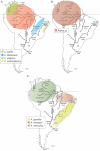Identification and characterization of highly divergent simian foamy viruses in a wide range of new world primates from Brazil
- PMID: 23844033
- PMCID: PMC3701081
- DOI: 10.1371/journal.pone.0067568
Identification and characterization of highly divergent simian foamy viruses in a wide range of new world primates from Brazil
Abstract
Foamy viruses naturally infect a wide range of mammals, including Old World (OWP) and New World primates (NWP), which are collectively called simian foamy viruses (SFV). While NWP species in Central and South America are highly diverse, only SFV from captive marmoset, spider monkey, and squirrel monkey have been genetically characterized and the molecular epidemiology of SFV infection in NWPs remains unknown. We tested a large collection of genomic DNA (n = 332) comprising 14 genera of NWP species for the presence of SFV polymerase (pol) sequences using generic PCR primers. Further molecular characterization of positive samples was carried out by LTR-gag and larger pol sequence analysis. We identified novel SFVs infecting nine NWP genera. Prevalence rates varied between 14-30% in different species for which at least 10 specimens were tested. High SFV genetic diversity among NWP up to 50% in LTR-gag and 40% in pol was revealed by intragenus and intrafamilial comparisons. Two different SFV strains infecting two captive yellow-breasted capuchins did not group in species-specific lineages but rather clustered with SFVs from marmoset and spider monkeys, indicating independent cross-species transmission events. We describe the first SFV epidemiology study of NWP, and the first evidence of SFV infection in wild NWPs. We also document a wide distribution of distinct SFVs in 14 NWP genera, including two novel co-speciating SFVs in capuchins and howler monkeys, suggestive of an ancient evolutionary history in NWPs for at least 28 million years. A high SFV genetic diversity was seen among NWP, yet these viruses seem able to jump between NWP species and even genera. Our results raise concerns for the risk of zoonotic transmission of NWP SFV to humans as these primates are regularly hunted for food or kept as pets in forest regions of South America.
Conflict of interest statement
Figures





References
-
- Aguzzi A (1993) The foamy virus family: molecular biology, epidemiology and neuropathology. Biochim Biophys Acta 1155: 1–24. - PubMed
-
- Khan AS (2009) Simian foamy virus infection in humans: prevalence and management. Expert Rev Anti Infect Ther 7: 569–580. - PubMed
-
- Kupiec JJ, Kay A, Hayat M, Ravier R, Peries J, et al. (1991) Sequence analysis of the simian foamy virus type 1 genome. Gene 101: 185–194. - PubMed
-
- Herchenroder O, Renne R, Loncar D, Cobb EK, Murthy KK, et al. (1994) Isolation, cloning, and sequencing of simian foamy viruses from chimpanzees (SFVcpz): high homology to human foamy virus (HFV). Virology 201: 187–199. - PubMed
-
- Blewett EL, Black DH, Lerche NW, White G, Eberle R (2000) Simian foamy virus infections in a baboon breeding colony. Virology 278: 183–193. - PubMed
Publication types
MeSH terms
Associated data
- Actions
- Actions
- Actions
- Actions
- Actions
- Actions
- Actions
- Actions
- Actions
- Actions
- Actions
- Actions
- Actions
- Actions
- Actions
- Actions
- Actions
- Actions
- Actions
- Actions
- Actions
- Actions
- Actions
- Actions
- Actions
- Actions
- Actions
- Actions
- Actions
- Actions
- Actions
- Actions
- Actions
- Actions
- Actions
- Actions
- Actions
- Actions
- Actions
LinkOut - more resources
Full Text Sources
Other Literature Sources

